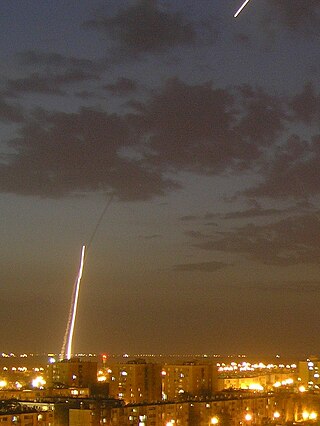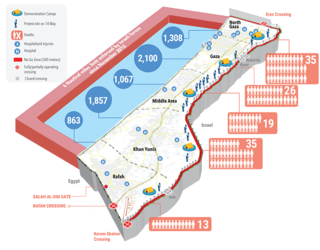Related Research Articles
In 2004, the Israeli Defense Forces launched Operation "Days of Penitence", otherwise known as Operation "Days of Repentance" in the northern Gaza Strip. The operation lasted between 29 September and 16 October 2004. About 130 Palestinians, and 1 Israeli were killed.
This page is a partial listing of incidents of violence in the Israeli-Palestinian conflict in 2005.

The 2006 Gaza–Israel conflict, known in Israel as Operation Summer Rains, was a series of battles between Palestinian militants and the Israel Defense Forces (IDF) during summer 2006, prompted by the capture of Israeli soldier Gilad Shalit by Palestinian militants on 25 June 2006. Large-scale conventional warfare occurred in the Gaza Strip, starting on 28 June 2006, which was the first major ground operation in the Gaza Strip since Israel's unilateral disengagement plan was implemented between August and September 2005.

The Gaza War, also known as Operation Cast Lead, also known as the Gaza Massacre, and referred to as the Battle of al-Furqan by Hamas, was a three-week armed conflict between Gaza Strip Palestinian paramilitary groups and the Israel Defense Forces (IDF) that began on 27 December 2008 and ended on 18 January 2009 with a unilateral ceasefire. The conflict resulted in 1,166–1,417 Palestinian and 13 Israeli deaths. Over 46,000 homes were destroyed in Gaza, making more than 100,000 people homeless.
Timeline of the Gaza War. For events pertaining to the conflict which occurred before 27 December 2009, see Gaza War (2008–2009)#Background and 2007–2008 Israel–Gaza conflict.
Incidents in the Gaza War include incidents involving attacks against civilians, a school, a mosque, and naval confrontations.

The Zeitoun killings refer to the Israeli military incursion, led by the Givati Brigade unit of the Israel Defense Forces (IDF), into the Zeitoun district of Gaza as part of the three-week 2008–09 Gaza War. In the Arab world, it is referred to as the Zeitoun District Massacre. A total of 48 residents of Zeitoun were killed, most of them women, children, and the elderly; 27 homes, a mosque and a number of farms were destroyed by Israeli forces.
Accusations of violations regarding international humanitarian law, which governs the actions by belligerents during an armed conflict, have been directed at both Israel and Hamas for their actions during the 2008–2009 Gaza War. The accusations covered violating laws governing distinction and proportionality by Israel, the indiscriminate firing of rockets at civilian locations and extrajudicial violence within the Gaza Strip by Hamas. As of September 2009, some 360 complaints had been filed by individuals and NGOs at the prosecutor's office in the Hague calling for investigations into alleged crimes committed by Israel during the Gaza War.

Khalil al-Mughrabi was an 11-year-old Palestinian boy who was killed while resting with friends after a game of soccer in Rafah on 7 July 2001, by shots fired from an Israel Defense Forces (IDF) tank. Two of his companions, aged 10 and 12, were also seriously wounded. This incident took place during the Second Intifada.

The 2006 Gaza cross-border raid was an armed incursion carried out by seven or eight Gazan Palestinian militants on 25 June 2006 who attacked Israel Defense Forces (IDF) positions near the Kerem Shalom Crossing through an attack tunnel. In the attack, two IDF soldiers and two Palestinian militants were killed, four IDF soldiers were wounded, one of whom was Gilad Shalit, who was captured and taken to the Gaza Strip.

The Hannibal Directive is the name of a controversial procedure that was used by Israeli Defense Forces (IDF) until 2016 to prevent the capture of Israeli soldiers by enemy forces. According to one version, it says that "the kidnapping must be stopped by all means, even at the price of striking and harming our own forces." It was introduced in 1986, after a number of abductions of IDF soldiers in Lebanon and subsequent controversial prisoner exchanges. The full text of the directive was never published, and until 2003, Israeli military censorship forbade any discussion of the subject in the press. The directive has been changed several times, until it was officially revoked in 2016 by IDF chief of staff Gadi Eizenkot. The Directive's replacement has not been published.

In November 2012, the Israel Defense Forces (IDF) launched Operation Pillar of Defense, which was an eight-day campaign in the Hamas-governed Gaza Strip, beginning on 14 November 2012 with the killing of Ahmed Jabari, chief of the Gaza military wing of Hamas, by an Israeli airstrike.

The Battle of Shuja'iyya occurred between the Israel Defense Forces and the Izz ad-Din al-Qassam Brigades on 20 July 2014 during 2014 Israel–Gaza conflict in the Shuja'iyya neighborhood of Gaza City, in the Gaza Strip. Shuja'iyya, with 92,000 people in 6 sq-kilometres, is one of the most densely populated areas of the Gaza Strip. According to the IDF, it had become a "terrorist fortress", that between 8 and 20 July had fired over 140 rockets into Israel after the outbreak of hostilities. Casualty figures are not known with precision, partly because bodies were recovered long after the fighting, and people had also died of injuries afterwards. The UN Protection Cluster states that between the 19-20th, 55 civilians, including 19 children and 14 women, were killed as a result of the IDF's actions. At the time, estimates varied from 66 to about 120 Palestinians killed, with a third of them women and children, and at least 288 wounded. The UN figures of Palestinian casualties are preliminary and subject to revision. 16 Israeli soldiers were killed.
The following is a timeline of the 2014 Gaza War. Over 2014, Palestinians suffered the highest number of civilian casualties since the Six-Day War in 1967, according to a United Nations report, given the July–August conflict, and rising tolls in the West Bank and East Jerusalem. A spike in Israeli casualties also occurred. 2,256 Palestinians and 85 Israelis died, while 17,125 Palestinians, and 2,639 Israelis suffered injuries.
This is a list of individual incidents and statistical breakdowns of incidents of violence between Israel and Palestinian dissident factions in 2014 as part of the Israeli–Palestinian conflict.
This is a Timeline of events related to the Israeli–Palestinian conflict during 2016.

The 2018–2019 Gaza border protests, also known as the Great March of Return, were a series of demonstrations held each Friday in the Gaza Strip near the Gaza-Israel border from 30 March 2018 until 27 December 2019, in which Israeli forces killed a total of 223 Palestinians. The demonstrators demanded that the Palestinian refugees must be allowed to return to lands they were displaced from in what is now Israel. They protested against Israel's land, air and sea blockade of the Gaza Strip and the United States recognition of Jerusalem as capital of Israel.

Rouzan Ashraf Abdul Qadir al-Najjar was a Palestinian nurse/paramedic who was killed by the Israeli Defense Forces (IDF) while volunteering as a medic during the 2018 Gaza border protests. She was fatally hit by a bullet shot by an Israeli soldier as she tried to help evacuate the wounded near Israel's border fence with Gaza. The IDF first denied that she was targeted, while not ruling out that she may have been hit by indirect fire. Israeli human rights group B'Tselem said that al-Najjar was shot intentionally.
In specific cases there were incidents of friendly fire in the 2023 Israel–Hamas war. The vast majority of casualties in the conflict were killed by the opposing side, i.e. Israelis killed by Palestinian militants and Palestinians killed by the Israeli military.
References
- 1 2 3 4 مشردو قطاع غزة ما زالوا ينتظرون مساعدات حماس الموعودة Archived 2011-07-07 at the Wayback Machine , Al-Hayat al-Jadida, January 27, 2009; Mushardo Gaza Strip are still waiting for promised aid Hamas, Google Translation; Gaza victims describe human shield use [ permanent dead link ], JPost, January 29, 2009
- ↑ خالد عبد ربه لـ«الشرق الأوسط»: قتلوا بناتي أمام عيني وعجزت عن مساعدتهن Archived 2011-07-16 at the Wayback Machine , Asharq Al-Awsat, January 25, 2009; Khaled Abd Rabbo told «Middle East»: Girls killed in front of my eyes and unable to help them, Google translation
- ↑ "Father says children were carrying white flags when shot dead by Israelis". The Irish Times . January 26, 2009
- ↑ "As Constraints on Gaza Ease, New Reports of Misery". The Washington Post . January 22, 2009.
- ↑ "New evidence of Gaza child deaths". BBC. January 22, 2009.
- ↑ "Gaza family says Israeli soldier shot children". The Sydney Morning Herald . January 24, 2009.
- ↑ "Voices from The Rubble". Time . January 29, 2009.
- ↑ "22 Days of Death and Destruction". Amnesty. July 2009. pp 25-26.
- ↑ Gaza white flag deaths probe call, BBC, August 13, 2009
- ↑ Report: IDF killed women and children with white flags in Gaza, YNET, August 13, 2009
- 1 2 3 4 White Flag Deaths, HRW, August 13, 2009
- ↑ Crime Against Humanity, Maariv, 21 August 2009
- ↑ Public hearings – Gaza City, Afternoon Session of 28 June 2009 Archived February 19, 2011, at the Wayback Machine
- 1 2 Report of the United Nations Fact-Finding Mission on the Gaza Conflict, UNHRC, September 25, 2009, para. 777
- ↑ Goldstone Report Endorses Unreliable Witnesses, CAMERA, September 16, 2009
- ↑ Blocking the Truth of the Gaza War Archived 2009-09-27 at the Wayback Machine , JCPA, September 18, 2009
- ↑ Analysis: Blocking the truth behind the Gaza war Archived 2011-07-19 at the Wayback Machine , JPost, September 21, 2009